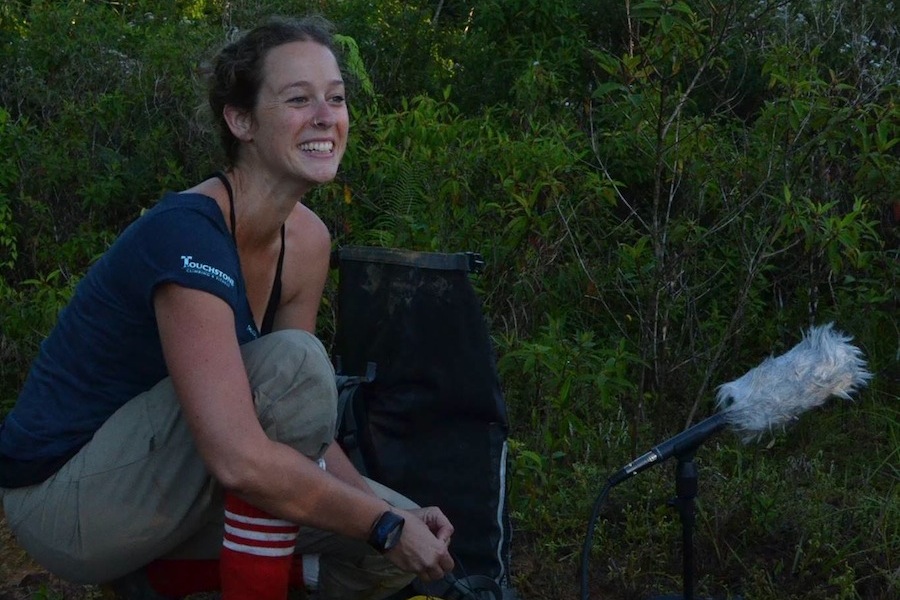
UC Davis predoctoral anthropology student studies bioacoustics of Bornean gibbons
In the Malaysian jungle, the Bornean gibbon sings at dawn — and Dena Clink, a fifth-year UC Davis predoctoral anthropology student, records them.
Clink’s research analyzes Bornean gibbon vocalizations in order to answer the fundamental question of which evolutionary forces — natural selection or drift — shape geographic variation in their calls. Clink also employs a method of vocal fingerprinting to examine individuality in gibbons, which can be potentially used for large-scale population monitoring for conservation purposes.
Clink explored the evolutionary forces behind gibbon vocalizations by studying them directly in the field. The research began by collecting data at multiple fixed-point counts, requiring researchers to sit in the forest and record everything they hear. Unfortunately for Clink, gibbons start singing around 5:30 a.m., meaning she had to be out at the points — some of which were a mile and a half-long hike away — by that time or even earlier.
“[My research assistants and I] would have to get up at 4 a.m. and hike. It’s so funny because it’s dark and there are so many things rustling around in the jungle,” Clink said. “The thing that scared me the most were the Bornean bearded pigs. They’re really cute, but they make this horrible screaming sound when they get scared. So, I’d be walking with just a flashlight and then they’d scream and I’d be like, ‘Oh my god what is that?!’”
After the fix-point counts were completed, Clink would gain an idea of the whereabouts of nearby gibbon groups and would conduct playbacks — pre-recorded gibbon calls that would sound out of a giant speaker to elicit a vocal response out of wild gibbons.
“All of the sudden you see the trees just going wild, and these apes fly out and you can actually see them […] it’s so cool, because it’s so hard to see them otherwise”, said Allison Jones, a third-year evolution, ecology and biodiversity major, who worked for Clink as a field research assistant. “It was a really cool experience after two years of listening to their recordings to actually see the animal in person.”
After studying and recording the calls, Clink’s team studied the area itself to examine the interaction between forest density and call type. The gibbon’s vocalizations, while highly individualized between each animal, also varied with the density of the forest that they live in, with thinning forests corresponding to changing calls.
“There’s evidence that you could predict that if a forest is more dense, if there’s more tall trees or the canopy is more closed, that that’s going to influence how the sound travels, and that natural selection may have then shaped the gibbon calls,” Clink said.
Clink’s second research focus, vocal fingerprinting, utilizes the highly-personalized gibbon calls for cataloging and identification purposes, allowing researchers to track the fast-moving primates more easily, both as a group and individually. By identifying them based on their calls, researchers are able to accurately count and monitor the population.
On top of providing researchers a new way to study primate movement and activity, one of Clink’s goals for her research is to apply its results to a population of gibbons at the Stability of Altered Forest Ecosystems (SAFE) site. SAFE is a large-scale fragmentation experiment, in which the forest is cleared of trees except for six fragments, or forest islands, giving scientists a baseline of understanding on how the animals who inhabit the forest sustain themselves both before and after the deforestation.
“The scientists and the researchers are not the reason that the forest is getting cleared,” Clink said. “This land has been slated to be converted [into oil palm plantations] for a long time, and the researchers are making the best of a bad situation.”
The natural habitat of the gibbon has been destroyed over the last few decades as palm oil farming has expanded in Borneo. It is Clink and Jones’ hope that this body of research can be used to raise awareness for the impact that palm oil production has on existing primate populations.
According to Dr. Margaret Crofoot, an assistant professor in UC Davis’ anthropology department and Clink’s Ph.D. advisor, tropical forests across the globe are being destroyed at an alarming rate, especially the tropical forest in the Malaysian-Indonesian archipelago.
“Primates that live in that forest [are] critically endangered by human development and destruction of their habitat,” said Dr. Crofoot. “Any important conservation effort requires both active steps like protecting natural areas, but they also require monitoring to see how well the approach you’re taking is working. I think that’s really where [Clink’s] work has the potential to make a really positive impact.”
Both Clink and Jones, despite the early wake-up calls and Bornean bearded pigs, are eager to return to Malaysia and research more in the field as deforestation in the region continues.
“It’s tough work, you have to get up early, it’s a lot of hiking and carrying a lot of heavy stuff, but once you’re out in the jungle at sunrise, there’s nothing better,” Clink said.
Written by: Ariel Robbins – science@theaggie.org




